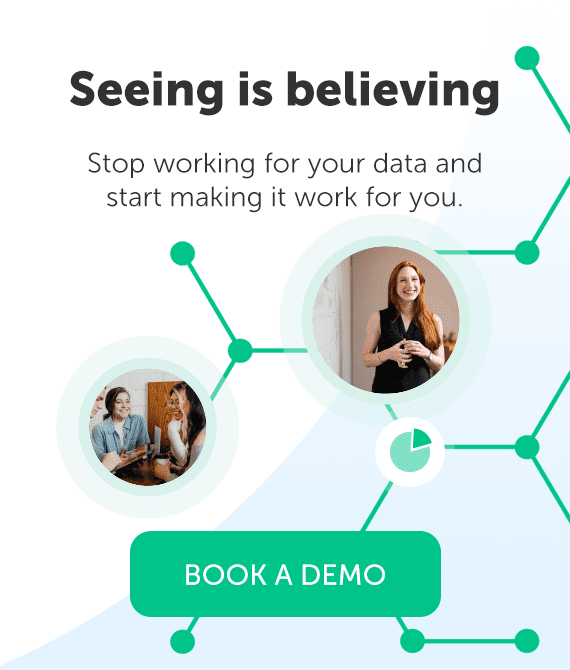B2B companies spend between $190-$1,985 on average to acquire a new customer. That doesn’t even include the cost of sales prospecting and data entry, which takes up nearly 70% of the work week. This adds another $42,000 for each sales rep (based on a $60,000 salary). Generally, new revenue opportunities need to spend 3X more than the acquisition costs to have a solid ROI. Filling your pipeline doesn’t have to cost an arm and a leg. Customer data can be a goldmine of untapped revenue if you know where to look. Keep reading to learn how Customer Intelligence can help sales teams identify opportunities without spending tons of money.
3 Steps to identify revenue opportunities
Collect customer data
Customer data is the best source for finding revenue opportunities. While B2B companies are collecting more data than ever before, nearly two-thirds of organizations struggle with managing all of the information. The biggest challenge is keeping up with leads switching jobs, companies, or contact information. These changes make 70% of customer data obsolete every year.
Rather than spending hours every week updating contact records that will quickly become outdated, companies are investing in CRM sales automation. This technology taps into readily available sources—emails, VOIP calls, calendar appointments, social media—to create an accurate database of customer information and interactions.
Sales automation captures:
- Employment history
- Contact records
- Job changes
- Promotions
- Company mergers
- Phone calls
- Sales emails
- Marketing campaigns
Access to reliable, real-time customer data equips salespeople with insights rather than relying on intuition. According to McKinsey research, this solution can increase selling time by 15-20%, while increasing deal-flow transparency and conversion. Early adopters of sales automation also report efficiency improvements of 10-15% and increases in customer-facing time.
Analyze customer insights
Having accurate data is of little value if you don’t know how to use it. Making sense of disparate numbers and charts used to require expensive data scientists. Customer Intelligence does this in less time for a fraction of the cost. This AI-based technology uses machine learning to convert raw data into actionable insights that identify revenue opportunities for existing and new accounts.
Customer Intelligence reveals:
- Contact scores to identify the most promising leads
- Relationship maps for warm introductions to key stakeholders
- Role changes and departures to keep deals in motion
- Executive-level relationships for strong deal alignment
Organizations are investing trillions to become more data-driven, but only 8% successfully scale analytics to get value from their data. Having a central source of accessible customer insights creates a competitive advantage for sales teams to improve and leverage customer experiences at every touchpoint. Forrester Research estimates that increasing data accessibility by just 10% could increase annual net incomee by more than $65 million.
Customer Intelligence delivers a 360-degree view of internal and external relationships to help sales reps find the quickest path to revenue and increase deal velocity. Research indicates organizations that leverage customer behavioral insights outperform competitors by 85% in sales growth and more than 25% in gross margin.
Predict customer needs
Sometimes, customers don’t know what they need until they need it, so it’s up to sales teams to be proactive. Predictive analytics looks at current and historical data to identify gaps in customer needs. These gaps are the “white space” in accounts that have cross-sell and upsell revenue opportunities.
Predictive analytics identifies:
- Cross-sell and upsell opportunities in existing accounts
- Seller behavior with high conversions to improve forecasts
- Account recommendations for renewal and retention
- New market segments with high-closing potential
Another way sales teams can use predictive analytics is to track customers who are at risk of leaving, and take steps to retain them. Companies that use predictive analytics to mitigate churn risk and build customer loyalty can increase retention rates by up to 5%, which translates to a profit boost of 25-95%.
When you understand customer interactions, you can better predict buying behavior and offer personalized solutions to leads that are ready to buy. As a result, sales teams can reduce customer acquisition costs by up to 50%. McKinsey research also found that companies leading the charge in personalization generate 40% more revenue.
The bottom line
High-quality, trusted insights are the secret ingredient to successfully manage and meet growing expectations. Harnessing data effectively will create a customer-centric culture to help sales teams sell smarter, not harder. Companies that adopt customer-centric selling grow 2x faster and are 60% more profitable than the competition.
Introhive’s Customer Intelligence Cloud has helped over 200,000 companies worldwide unlock the power of customer insights to find new leads, win more deals, and grow existing accounts. When reliable information is at your fingertips, sales teams can minimize the guesswork of sourcing new revenue opportunities. Ask one of our Customer Intelligence Specialists about how your team can leverage your existing data and networks to create more revenue opportunities over the entire customer lifecycle.






